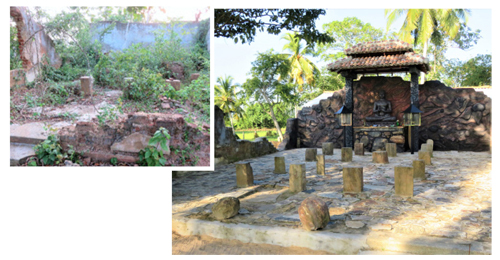Village youth and monk bring back Aranwela’s lost historical site

Mission accomplished: Before (left) and (above) after restoration
Kirama Oya meanders through the fields on its way to reach the Indian Ocean, its origins said to be in the rain-rich lush mountains of Kirama. During its not so long journey to unleash its precious collection into the sea at Tangalle, the flow is stemmed at several locations to irrigate the dry plains of the west of Hambantota district. These anicuts had been built during colonial times but many were there during the Kandyan Kingdom as well. A historical temple had once existed overlooking one of these anicuts.
Between coastal Tangalle and the inland town of Beliatta, Kirama Oya separates two sleepy villages of Aranwela and Angulmaduwa. Whilst Aranwela is famous for its vast stretch of paddy fields called the ‘Aranwela wel yaya’ – virtually filling most of the landmass between Tangalle and Beliatta – Angulmaduwa is well known for brassware manufacturing. The industry is said to have flourished there from the time of the King.
The deeply rooted history of the two neighbouring villages had rightfully earned them the ‘ancient village’ tag (purana gam).Both villages have ‘purana viharas’ though the Aranwela temple no longer exists except the stone stilts the irreplaceable image house was built upon (atampita vihara – one of the 16 in the island). It nestled in a great clump of trees on the right bank of the river in the middle of rice fields. Its dilapidated walls on which colourful murals were drawn 200 years ago and its fine set of sculptures of the Buddha and deities survived till the late ’80s, but there was no conservation as the authorities were preoccupied with quelling the infamous rebellion of the deep south which saw the solitary monk occupying the temple moving into the village temple for security.
Thereafter, the temple and the artifacts were badly vandalised by treasure hunters. The priceless gem-studded gold relic casket, delicately erected on the back of a silver elephant, was found a decade later, dumped in a drain many miles away sans the gold and the stones.
It is in this wake a miracle happened between October and December 2021.
The neglected site that had become a haven over the years for village rogues, drug addicts, alcoholics and those involved in nefarious activities has now been transformed into a place of worship by the pious youth of the village. Though they couldn’t restore the old building to its former glory, with hardly a photograph available, they have done a remarkable job within three months in the absence of archaeologists, architects or engineers among them. During the work-in-progress they unearthed evidence engraved in marble to say the last restoration of the site had been in September 1932. Sadly, none remembers anything of it now. It was when the sanctuary was a living temple.
The scholarly monk who is deputy head of the Aranwela purana viharaya guided the youth whilst a few kind donors of the village generously funded the project. No politician was involved even at the village level nor any VIPs and the only favour they sought from the government was to get-down a large tractor of the secretariat to remove the cartload of arrack bottles, beer cans and whatnot, strewn on the sacred site for no less than three decades!
Now, many vehicles travelling on the short-cut from Angulmaduwa to Beliatta via Aranwela make it a point to reduce speed or stop and pay homage at the site. Considering what an enchanting place it has turned out to be after the restoration, the monk from the village wishes to establish a meditation centre there without erecting any structures.
With this noble thought in mind he has now embarked on a mission to landscape the vast garden with forest trees in addition to what’s preserved. Already peacocks are seen dancing in the mornings and fishing cats prowl at night. The site is barbed wired, and a proper gate has been installed to deter unsavoury frolics.
Meanwhile Kirama Oya flows languidly on the fringes of the site, saluting the farming youth of Aranwela for their meritorious act. Perhaps, the ancient Bodhi tree in the fields in front of the site remembers its former splendour. The tree is said to have been a direct sapling of the most sacred ‘Jaya Sri Maha Bodhi’of Anuradhapura.
Searching for an ideal partner? Find your soul mate on Hitad.lk, Sri Lanka's favourite marriage proposals page. With Hitad.lk matrimonial advertisements you have access to thousands of ads from potential suitors who are looking for someone just like you.


